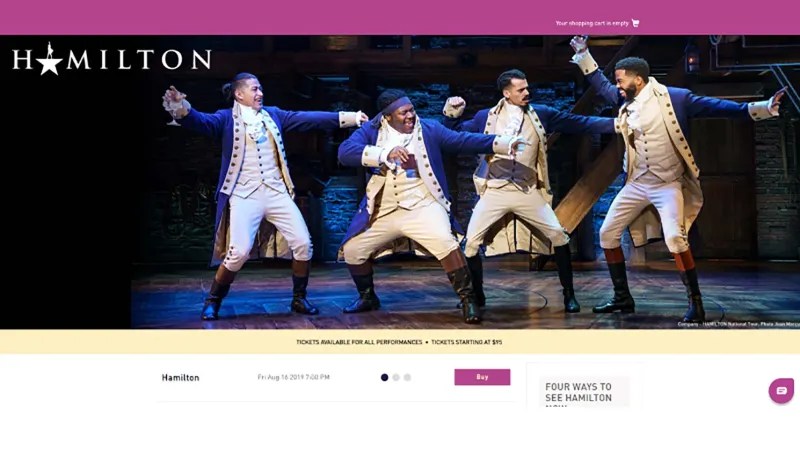At AVConnect 2019, AudienceView Unlimited’s annual users conference, we hosted a panel to showcase how performing arts organizations can use microsites to drive branding efforts and ticket sales.
The participants were:
- David Cushing – VP, Ticketing at BroadwaySF
- Christina Pryor – Ticketing System Administration Manager at Opry Entertainment Group
- Morgan Wedge – Chief Solutions Officer at TixiT Ticket Company
Before diving in, let’s answer an important question: what is a microsite?
A microsite is an individual website or cluster of pages, meant to complement an existing website.
It is separate from your main website and delivers more focused content. Microsites are often focused on a specific topic for a targeted audience and drive that audience towards a particular action.
For example, BroadwaySF uses a microsite for its Hamilton on-sales, as you can see here.
This microsite allows BroadwaySF to present Hamilton-specific information to its audiences, including show and venue information, an FAQ and direct links where patrons can purchase tickets.
Additionally, this microsite separates traffic flow from the main BroadwaySF website and allows them to conduct dedicated reporting for this site. As we all know, Hamilton is an extremely popular show. By conducting sales for Hamilton on a microsite, BroadwaySF can also avoid having that traffic cause problems on their main website.
There are several other use cases for microsites in performing arts. For example, microsites can be used for separate business units or external clients. TixiT, for example, is an agency that sells tickets on behalf of its clients. They create microsites for each of their individual clients.
This provides many benefits to TixiT’s clients. They can customize the branding of each microsite to meet the needs of individual clients and manage them in a separate environment. Additionally, each microsite gets its own analytics tracking, making it easier for TixiT to measure and optimize key metrics.
SHN has a microsite specifically for renewals. This allows them to provide a unique experience relative to what their general audience sees on their main website. It also allows them to display customized content directed at their members.
Opry Entertainment Group has a couple of unique microsites as well. These include an employee benefit site and a microsite for partners. The partner microsite allows ticket buyers to easily log in and place orders at a discounted partner rate rather than tying up Opry’s box office or call center staff. This also helps to track ticket sales from partners more easily.
Microsites can provide a variety of benefits to your business. Along with the ability to offer different experiences to different customer groups, microsites allow you to customize branding, messaging, content and navigation.
Additionally, tracking activity through a microsite makes it easier to get accurate reporting, so you can measure actions like ticket purchases that come through your microsite and your conversion rate.
As we mentioned earlier, microsites also allow you to segregate traffic and payment processing, ensuring that visitors on your primary site are not negatively affected by a burst in traffic related to an on-sale. On-sales are some of the most common use cases for microsites in AudienceView Unlimited.
So now that we’ve (hopefully) convinced you of the value of creating microsites for your performing arts organization, let’s talk about how you should go about actually creating them.
First, it’s important to note that ticket sales microsites are a partnership between marketing and ticketing. Marketing is responsible for creating the content, while ticketing is responsible for the sales process. Christina Pryor at Opry suggests having a weekly, 15-minute standup between these two groups to bring up any issues or needs. It’s also important to review the microsite’s content regularly for things such as branding and terms and conditions.
Before we even get there though, it’s important to have a strong plan and infrastructure in place to manage your microsites. The creation of the website should belong to a web manager, who then works with ticketing on the requirements to develop a ticketing microsite. It’s important to plan out user roles, permissions and a content schedule to ensure your microsites are properly managed. You should also have someone acting as a project manager to make sure everyone remains on task and that your microsites are achieving their objectives.
Microsites provide many benefits to your organization. These include customizable branding, streamlined traffic flows, better reporting and increased ticket sales. In AudienceView Unlimited, we make it possible to build microsites to help drive your branding and ticket sales.
